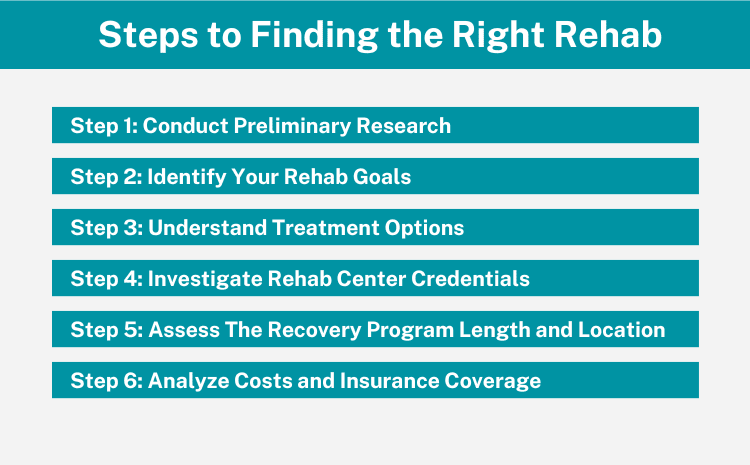HOW TO CHOOSE A REHAB FACILITY
Choosing the right rehab facility is a crucial step on the path to recovery. It’s the place where healing begins, and finding the right one can make all the difference. The right rehab offers not just quality treatment but also a supportive environment that meets your specific needs. Whether it’s dealing with substance use disorders, mental health issues, or both, the right facility provides the tools and support necessary for a successful recovery. Understanding how to select the best option is essential for anyone looking to start their journey towards healing.

Steps to Finding the Right Rehab
Finding the right rehab facility is crucial but complex. The process involves navigating through a variety of treatment options, each with its unique approach to addressing substance use disorders. For example, consider the difference between a residential treatment center, offering a structured environment for around-the-clock care, and an outpatient facility, which allows patients to maintain their daily routines while receiving treatment. This means that the right rehab for one person might not suit another.
This means that choosing the right rehab involves more than just picking a name from a list. It requires thoughtful consideration of various rehab options to ensure the center can provide effective treatment for the individual.
To make this choice, you’ll need to consider several key factors such as:
- Type of Substance Use Disorder
- Treatment Methods
- Facility’s Credentials
- Aftercare and Support
While the task of finding the perfect rehab facility might seem daunting at first, following this guide will help you make a more informed decision.
Step 1: Conduct Preliminary Research
Before diving into the search for an addiction treatment center, it’s crucial to start with some groundwork. Understanding addiction and how it affects individuals differently is key. For instance, alcohol addiction can lead to severe withdrawal symptoms that are quite different from those associated with other substances, such as certain prescription drugs that might not have intense withdrawals but can still be challenging to quit due to psychological dependency.
This initial research phase is vital for families and individuals alike. It helps in grasping the basics of addiction medicine and the various substance use disorders. A guide for families can be especially helpful during this time, providing insights into what to expect from different treatment programs.
How addiction works: Learn about how addiction affects the mind and body.
- Different kinds of addictions
- What happens in detox
- Kinds of treatment
- How well treatments work
- Mental health and addiction
- Staying sober after rehab
Starting with these topics will help you feel more prepared to choose the right treatment path.
Step 2: Identify Your Rehab Goals
Identifying your rehab goals is like setting the destination for your journey to recovery. It’s about understanding what you want to achieve through addiction treatment. This clarity is crucial because every rehab program has its unique strengths, focusing on different aspects of recovery, from mental health support to overcoming alcohol or drug addiction. To find the right place for your recovery, you must align these program specialties with your personal recovery goals.
First, consider your current situation regarding substance use and reflect on which substances or behaviors you are trying to recover from. Are you battling opioid addiction, alcohol dependence, or another form of substance abuse? Then , consider any underlying issues you might face, such as anxiety or depression, which could influence your treatment needs.
Here’s a simple list to help you assess your treatment goals:
- What substances are you using, and for how long have you been using them?
- Are there any mental health conditions or medical issues you are currently facing?
- What behaviors or patterns related to your substance use do you wish to change?
- Do you think an inpatient program (where you stay at the rehab center) or an outpatient program (where you live at home and visit for sessions) would be more beneficial for you?
- Do you require a detox program to help manage withdrawal symptoms safely?
If you find these questions overwhelming or are unsure about how to proceed, remember that you don’t have to navigate this process alone. For additional guidance and support in setting and achieving your rehab goals, consider reaching out to a professional addiction treatment provider. They can offer personalized advice and help you explore your options to ensure you find the path to recovery that’s best suited to your needs.
Step 3: Understand Treatment Options
Understanding the available treatment options is crucial in choosing the right path for recovery. Depending on how severe the addiction is, the journey might include different levels of care. Let’s break down the options:
- Detoxification is the first step for many. It’s a medically supervised process to safely manage withdrawal symptoms from drugs or alcohol. This stage is critical and can last from days to weeks, depending on the substance and the person’s condition.
- Inpatient/Residential Rehab offers a place to live while getting 24/7 care. This option is best for those needing constant support and has structured programs that can last from a few weeks to several months. After completing an inpatient program, transitioning to outpatient care is common.
- Outpatient Rehab and Intensive Outpatient Programs provide flexibility, allowing individuals to continue their daily activities while receiving treatment. These programs are ideal for those with obligations at home, work, or school that make living at a rehab center impractical. Sessions can be scheduled around personal responsibilities, including options for evenings and weekends.
Each of these approaches includes various treatment methods to address addiction’s root causes and help maintain long-term recovery.
Consider The Therapy Used in Addiction Treatment
Besides considering the treatment approaches, it's important to consider the treatment methods as well. Understanding the various treatment approaches can play a crucial role in creating a successful treatment program. Here's a closer look at the methods typically used in rehabilitation settings:
- Individual Therapy: Offers personalized sessions with a therapist to work through addiction issues.
- Group Therapy: Provides a supportive environment where individuals can share experiences and strategies under therapist guidance.
- Family Therapy: Engages family members in the recovery process, recognizing the role of family support.
- Cognitive Behavioral Therapy (CBT): Aims to identify and reframe negative thoughts and behaviors into positive outcomes.
- Dialectical Behavior Therapy (DBT): Focuses on improving emotional regulation and mindfulness to reduce self-destructive behaviors.
- Motivational Interviewing (MI): Helps individuals find the motivation within themselves to change their behavior and adhere to the treatment plan.
Each approach has its benefits and is often combined to create a comprehensive treatment plan tailored to the individual's needs.
Step 4: Investigate Rehab Center Credentials
Checking a rehab center’s credentials is a key step in the selection process. Why? Because its credentials prove that the facility meets high standards for care and safety. Here’s what to look for:
- Accreditation: Shows the center has passed rigorous evaluations by independent organizations.
- Licensing: This means the center is legally allowed to operate in your state.
- Certifications: Indicate specialized training and qualifications of the staff.
Choosing a facility with these credentials ensures you or your loved one will receive quality treatment in a safe, professionally recognized environment.
Step 5: Assess The Recovery Program Length and Location
Considering the length and location of a rehab program is crucial in your recovery journey. The duration of the program can vary, ranging from short-term stays of 30 days to long-term options that last several months. The right length for you depends on the severity of your addiction and your personal recovery goals. Similarly, the location of the rehab center can significantly impact your comfort and willingness to engage in the treatment process. Some may prefer a facility close to home for family support, while others might find recovery more effective in a new environment away from familiar triggers.
Step 6: Analyze Costs and Insurance Coverage
Rehab programs can vary in cost based on length of stay, type of program, and location. It’s crucial to check with your insurance provider to understand coverage details. Many rehab centers can assist you in this process, helping to clarify what your insurance will cover. Furthermore, most centers often provide financial assistance or payment plans, making it easier to manage expenses. Exploring these financial options can ease the burden, allowing you to concentrate on your recovery journey.
The Decision-Making Process
After researching and understanding the various aspects of rehab facilities, such as program lengths, costs, and what your insurance covers, it’s time to narrow down your options. Start by comparing the rehabs you’re considering. Look at the amenities they offer, the qualifications of their staff, and reviews from past patients. This can give you a clearer picture of what each center provides and how they might meet your needs. Then, discuss these options with treatment providers who can offer insights into the admission process and help further narrow your choices.
Special Considerations for a Rehab Facility
When selecting a rehabilitation center, there are additional factors to consider beyond the basics. The first factor to look at is whether the facility offers programs that cater to your specific situation. For example, some centers specialize in treating certain age groups, like teenagers or seniors, providing an environment and therapy tailored to their unique challenges.
Another important consideration is if the facility offers holistic therapies as part of their treatment programs. Holistic therapies aim to treat not just the addiction itself but the whole person, including physical, mental, and spiritual health. These therapies might include activities like yoga, meditation, acupuncture, and nutritional counseling. They can complement traditional treatments by helping to reduce stress, improve overall well-being, and provide new coping mechanisms.
Why Choosing Right Matters
The right treatment facility offers services tailored to the needs of individuals with substance use disorders, ensuring that patients receive the support necessary for their specific situation. This decision impacts not just the likelihood of achieving long-term recovery but also affects the overall journey towards wellness.
Conclusion
Selecting the appropriate addiction treatment facility is essential for a successful recovery journey. To assist you in initiating this process, here are several resources that can provide valuable information and support:
- SAMHSA National Helpline
- National Institute on Drug Abuse (NIDA)
- Alcoholics Anonymous (AA)
- Narcotics Anonymous (NA)
- National Alliance on Mental Illness (NAMI).
Leveraging these resources can empower you to make well-informed decisions about addiction treatment and support services, guiding you or your loved one on the path to recovery.
